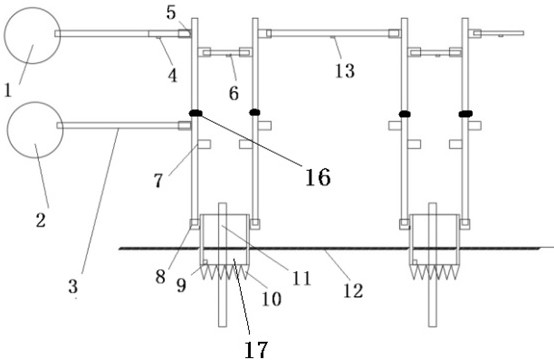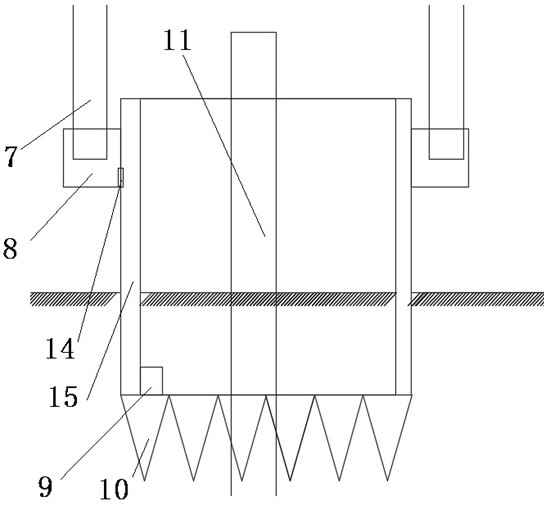Animal dead body biodegradation enzyme preparation and foliage fertilizer and method
A technology of animal carcass and foliar fertilizer, which is applied in the field of biological agriculture, can solve the problems of easy lodging, difficult erection and difficult picking of vine vegetables, and achieves the effects of rich nutrition, high efficiency and fast degradation speed.
- Summary
- Abstract
- Description
- Claims
- Application Information
AI Technical Summary
Problems solved by technology
Method used
Image
Examples
Embodiment 1
[0058] The animal carcasses were crushed, and the crushed animal carcasses were placed in a fermenter with a water content of 40%wt, treated at 121°C for 30min, and cooled by 40-50°C. Secondly, 0.5%wt was added to the compound enzyme preparation, and it was degraded at pH 6.0 and temperature 40°C for 24h. Finally, 0.3%wt was added to KNO 3 and Zn(NO 3 ) 2 Carry out enzymatic hydrolysis and chelation, treat at pH 6.0, temperature 40 for 24 hours, and filter to form biological foliage fertilizer. Degradation rate 93%
[0059] Taking watermelon as the experimental object, the root irrigation test was carried out: the biological foliar fertilizer was diluted 100 times with water at an amount of 5 kg per mu, and watered twice at the root of the plant during the growing period of watermelon and the vigorous fruit growth period.
[0060] Effect: the watermelons in the experimental group of the present invention are 15% more productive than those in the control group, and the chlo...
Embodiment 2
[0062] The animal carcasses were crushed, and the crushed animal carcasses were placed in a fermenter with a water content of 45%wt, treated at 121°C for 30min, and cooled to 45°C. Secondly, 0.3%wt was added to the compound enzyme preparation, and it was degraded at pH 5.0 and temperature 45°C for 18h. Finally, add KNO at 0.5%wt 3 and Zn(NO 3 ) 2 Carry out enzymatic hydrolysis and chelation, treat at pH 5.0 and temperature 45°C for 24 hours, and filter to form biological foliage fertilizer. The degradation rate is 94%.
[0063] Taking tomato as the experimental object, conduct a spraying test: the biological foliar fertilizer is diluted 100 times with water at an amount of 1 kg per mu, and sprayed on the leaf surface, leaf back, fruit and young stem during the tomato growth and expansion period; spray twice , with an interval of 1 week.
[0064] Effect: Compared with the control group, the tomato output of the experimental group of the present invention is increased by 21...
Embodiment 3
[0066] The animal carcasses were crushed, and the crushed animal carcasses were placed in a fermenter with a water content of 50%wt, treated at 121°C for 30min, and cooled to 50°C. Secondly, 0.1%wt was added to the compound enzyme preparation, and it was degraded at pH 7.0 and temperature 50°C for 18h. Finally, add KNO at 0.8%wt 3 and Zn(NO 3 ) 2 Carry out enzymatic hydrolysis and chelation, treat at a pH value of 7.0 and a temperature of 50°C for 18 hours, and filter to form a biological foliar fertilizer. The degradation rate is 91%.
[0067] Taking cucumbers as experimental objects, root irrigation and spraying tests were carried out: during the growth and colonization period of cucumbers, the biological foliar fertilizer was diluted 50 times with water at an amount of 4 kg per mu, and watered on the roots of the plants; The biological foliar fertilizer was diluted 300 times with water at an amount of 2 kg per mu, and sprayed on the leaf surface, leaf back, fruit and yo...
PUM
 Login to View More
Login to View More Abstract
Description
Claims
Application Information
 Login to View More
Login to View More - R&D
- Intellectual Property
- Life Sciences
- Materials
- Tech Scout
- Unparalleled Data Quality
- Higher Quality Content
- 60% Fewer Hallucinations
Browse by: Latest US Patents, China's latest patents, Technical Efficacy Thesaurus, Application Domain, Technology Topic, Popular Technical Reports.
© 2025 PatSnap. All rights reserved.Legal|Privacy policy|Modern Slavery Act Transparency Statement|Sitemap|About US| Contact US: help@patsnap.com


